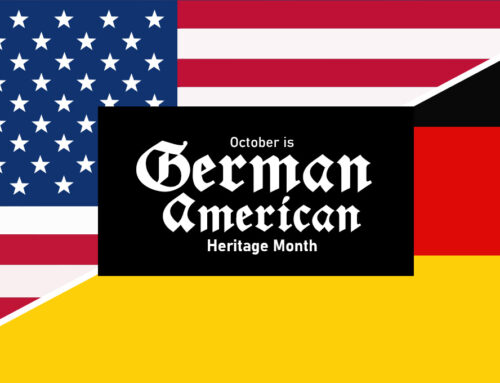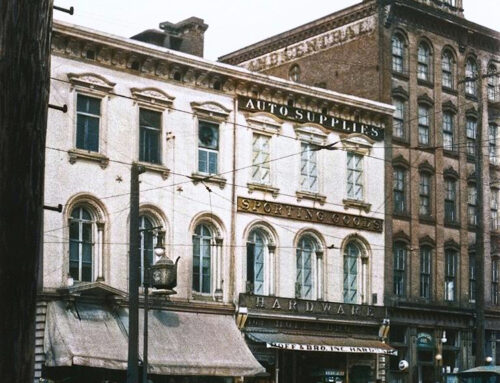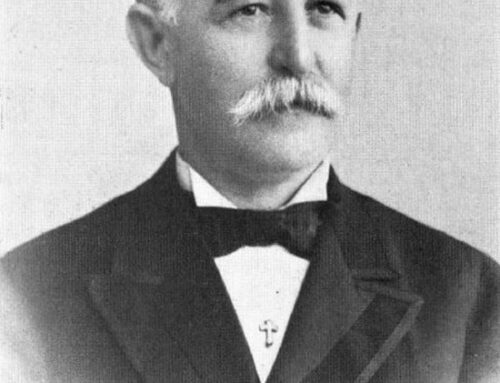Located at the Southwest corner of 8th and Penn Streets in Reading, PA is a building patterned architecturally after Carpenters’ Hall in Philadelphia, PA. The building, erected in 1929 by the Penn National Bank and Trust Co. on the site of its former bank building, cost $550,000 to build.
Below: Old Penn National Bank – Southwest corner of 8th and Penn Streets.


Few people know why Carpenters’ Hall was used as the model for the bank building. For a number of years Carpenters’ Hall was the home of the first bank in the country under federal auspices. It was in his hall that Robert Morris conducted his bank for the aid of congress during the revolution and later the First Bank of the United States.

In 1724 the Master Carpenters of Philadelphia organized an association called Carpenter Company. Their object was to obtain instructions in the science of architecture, and to assist such of their members as should be in need, and care for their widows and minor children. At first they rented a room for their meetings, but later on the association having been successful decided to buy a piece of ground, and erect a hall. In 1763 a committee was appointed to select a plot of ground suitable for their purpose, but it was not until 1768, after many discussions on the subject, that a plot was selected on the south side of Chestnut Street in Philadelphia, sixty-six feet on Chestnut street and two hundred and twenty-five feet in depth, paying an annual ground rent of one hundred and seventy-six Spanish milled pieces of eight of fine silver. Two years later in 1770 work was begun on the new building. The architect being Robert Smith, who prepared a sketch of a building, and his plan being accepted the work went steadily forward. The committee appointed did their duty faithfully and well that they were able to hold their annual dinner in it in January 1771, although it was not entirely finished until 1792.
During the Revolution Robert Morris conceived a plan to help congress raise money for necessary supplies for the Colonial army. He and several other wealthy patriots established a bank with their own money, and issued notes in payment of supplies for which congress was to repay them as fast as the money came in, and without any remuneration for themselves. The bank was opened in July, 1780 and being successful continued in operation until the establishment of the bank of North America in 1781. This led to other banks forming, and when Alexander Hamilton in his report on finance in 1790 recommended the establishment of a government bank his suggestion was speedily acted upon, and an act was adopted by congress for the purpose which President Washington signed and in 1791 the First Bank of United States was granted a charter for twenty years. The measure was very popular, the shares being worth $400 each. The bank commenced business in Carpenters’ Hall, and continued there until 1797, when it removed to its new building on Third Street above Walnut Street. Sometime before the expiration of the charter, application was made for a renewal, but it was considered unconstitutional by many and failed of renewal, and in 1811 wound up its affairs and closed its doors. In 1812 Stephen Girard bought the building and most of the stock, and started a private bank of his own. In 1817 the United States Bank was again granted a charter for 20 years, and again occupied the Hall.
History of Penn National Bank
The charter for the Penn National bank in Reading was secured March 12, 1883, and two days later the bank opened for business at 718 Penn street. It was in the fall of 1882 that the bank was first conceived with Isaac W. Levan, Adam Bard and Calvin D. Moser being the moving spirits. The idea of an up-town bank was received with great favor from the start. The name of the bank was suggested by the three promoters above named.
Opening for business March 14, 1883, the first bank statement was made in May, less than two months later, and this statement showed that the bank had deposits of $140,000 and discounts of $113,000. The bank for various reasons had several homes. At first it was situated at 748 Penn Street; in a year it moved to 758 Penn; in 1907 it moved to 758-60 Penn Street. Here the bank lived and thrived until the erection of a new structure in 1929. The bank was moved into temporary quarters on the opposite side of Penn Street. The building and the one on the left (762 Penn) were razed to make way for a new and larger Penn National Bank structure. In 1929 the present building located at the Southwest corner of Penn Streets was completed. The bank folded in the 1930s, shortly after President Roosevelt’s banking holiday. In 1938 the building was sold and converted to a six room commercial building.
Below: Penn National Bank Converted to a Commercial Building.


Below: Old Penn National Bank, 8th and Penn (September, 2015).

In 1999, the 24,000 sf, three-story brick and terra cotta building was purchased by the Berks County Convention Center Authority (BCCCA).
Renovations were begun in 2001 under the guidance of architect Lee Olsen who oversaw the restoration of the exterior.
In 2017, a $1.5M matching grant through the Redevelopment Assistance Capital Program (RACP), allowed the second phase of renovations to commence.
Entech Engineering was selected to provide design and construction services for the project including architectural (subcontracted to Aurora Architecture), mechanical (HVAC, plumbing and fire suppression), electrical (power, lighting and fire alarm), and structural. Structural design included a new entrance, steel reinforcing of building steel, floor repairs, new stairs to the basement, and an elevator.
In 2018, Burkey Construction, Reading, began the second phase. A new roof, new mechanicals and an elevator were installed as part of the project. Some interior finish work also was completed. To restore areas of the plaster that had been damaged by a roof leak, molds were made from the remaining details and used to duplicate decorative elements.
The design allocated space for a future restaurant and bar that would occupy portions of the 1st and 2nd floors as well as a commercial kitchen area. The remaining portion of the 2nd and the 3rd floor are intended to be used for meeting/event space. The basement and 3rd floor were brought up to code, but are otherwise unfinished.
The project will need additional funding for completion of the next scheduled phases. Once completed and occupied this building will once again be a focal point of downtown Reading.
Below: Interior renovations completed to date.

1907 Bank Building
On Saturday, Feb. 23, 1907 a new Penn National bank building was opened for business. The architect of the 1907 bank building was A. A. Richter, of the City of Reading. The new structure was built entirely of fireproof material, not a single piece of wood having been used. The construction was a steel skeleton faced in granite and enclosed in concrete; the floors were of reinforced concrete laid in marble mosaic, and the roof was concrete, covered with copper plate. The dome and skylights were all made of fireproof glass, set in wire mesh, and all windows and doors were of metal construction. The architectural scheme throughout was French Renaissance.
Below: Penn National Bank, 758 Penn Street. Photo taken in 1924, right before the building and the one on the left (762 Penn) were razed to make way for a new and larger Penn National Bank structure – which survives in a modified form.

The exterior presented an appearance of solidity and strength, typical of the business of the Penn National Bank, with its granite front, massive bronze doors (weighing two tons), and heavy bronze grill work, protecting the plate glass front overhead. Two magnificent solid bronze lamps flanked the doorway.
Entrance to the building was through a beautiful vestibule domed with stucco work in a sunburst design, supported by marble pilasters, the walls faced with art marble and floored in Italian marble mosaic, in the center of which was embedded the inscription “Penn National Bank” in colors.
Through the beautiful vestibule one entered the main banking room. The color scheme throughout was ivory and gold. The magnificent dome, 12 feet in diameter and 45 feet from the floor, was of art leaded glass in colors reflecting the light of the sun by day and concealed in its circumference arc a number of electric bulbs that reflected its beautiful colors at night.
At the left of the entrance was located the private office of the bank president, and at the right was a room for the public. These rooms, and also the vestibule, were divided from the main floor by a quartered oak screen finished in golden oak. On both sides of the main floor were glass desks supported on bronze fixtures and with solid bronze equipment for public use. The private office of the cashier adjoined the president’s office and connects with the general banking department.
All counters were of art marble, with Verde antique base, and topped with solid bronze grills and office fixtures. To the rear, facing the entrance was a massive vault, on the top of which was a synchronized clock, with a marble dial 30 inches in diameter.
The vault consisted of a double banking and safe deposit vault with separate and independent entrances to each department, each being protected by a massive steel door weighing 9,000 pounds. The entrances of the vault, consisting of the vestibule, outside and inside doors, weighed approximately 18,000 pounds each. The outside doors were locked with the latest improved automatic bolt actuating devices, controlled by triple movement, 72-hour time locks.
Story of Carpenters’ Hall
The story of Carpenters’ Hall is closely associated with the affairs of the city and nation. After nearly 10 years of political agitation and repressive legislation by the British Parliament leading to restrictions on the rights and privileges of the people inhabiting the 13 American Colonies, strong protests were heard in the legislative assemblies, and in May 1774, Paul Revere, of Boston, arrived in Philadelphia with the suggestion that a convention of the colonies be called.
In June 1774 a committee was appointed by the city of Philadelphia to meet in Carpenters’ Hall to initiate measures for calling a Provincial conference. Later an invitation was extended to the various counties of the province to meet the Philadelphia committee in conference on the 15th of July following. This provincial committee with the city committee met on that date in Carpenters’ Hall, and remained in session there until its important business was finished July 22, 1774.
The members of the provincial committee from Berks County were Edward Biddle, Daniel Broad-head, Jonathan Potts, Thomas Dundas and Christopher Shultz. At this conference a resolution was passed asserting the rights of the colonies, condemning the British Parliament for its unjust laws and restrictions against the colonists and recommended delegates to congress be appointed which later was done, and a time appointed to meet. But as the time drew near it was found they would be unable to meet in the state house as the state assembly was in session there. The Carpenters’ company offered them the free use of their hall it being the next largest hall in the city at that time.
A committee was appointed and on looking it over accepted it, and congress agreed to meet there September 5, 1774. The Royalist newspaper warned the Carpenters’ company that their hall might be confiscated and their necks inconveniently lengthened but the minutes of the meeting record, on the question being put, “Shall they be allowed to meet here?” voted that, “they shall.”
The congress was composed of such men as Washington, Patrick Henry, Richard Henry Lee, Peyton Randolph of Virginia, Mifflin, Ross and Dickinson from Pennsylvania, the two Adams from Massachusetts, and many others nearly as prominent. Peyton Randolph was first president and Charles Thomson secretary. When the congress convened early on the morning of September 5, 1774 the members were well aware of the dangers surrounding their meetings and all agreed at once to keep their deliberations inviolably secret.
Of the congress as a body Mr. Adams wrote, “It is such an assembly as never before came together on a sudden in any part of the world. Here are fortunes, ability, learning, eloquence acuteness equal to any I ever met within my life. Here is a diversity of religion, educations, manners, interests, such as it would seem impossible to unite in one line of conduct.” Some of the preliminary work was disposed of in the first two days with a resolution passed to open the congress with prayer. John Hancock, a wealthy Massachusetts merchant, waited upon Rev. Duche, pastor of Christ Church, and invited him to be present the next day.
On the morning of the seventh of September, 1774, Rev. Duche arrived in his ecclesiastical robe and led congress in prayer using the Anglican Book of Common Prayer. Those who were present for this prayer meeting included: Samuel Adams, John Adams, George Washington and other great patriots, such as Pennsylvanian, John Morton. John Adams later wrote home to his wife, Abigail, that God’s providence must have been overseeing the prayer service. The reason for this remark was that there had been rumors that the British army had just attacked the city of Boston and the biblical text prescribed by the Book of Common Prayer for that day was Psalm 35. Verse 1 states, “Plead my cause, O LORD, with them that strive with me: fight against them that fight against me” (KJV).
Rev. Duche began his prayer saying, “O Lord our Heavenly Father, high and mighty King of kings, and Lord of lords, who dost from thy throne behold all the dwellers on earth and reignest with power supreme and uncontrolled over all the Kingdoms, Empires and Governments; look down in mercy, we beseech Thee, on these our American States, who have fled to Thee from the rod of the oppressor and thrown themselves on Thy gracious protection, desiring to be henceforth dependent only on Thee. To Thee have they appealed for the righteousness of their cause; to Thee do they now look up for that countenance and support, which Thou alone canst give. Take them, therefore, Heavenly Father, under Thy nurturing care; give them wisdom in Council and valor in the field; defeat the malicious designs of our cruel adversaries; convince them of the unrighteousness of their Cause and if they persist in their sanguinary purposes, of own unerring justice, sounding in their hearts, constrain them to drop the weapons of war from their unnerved hands in the day of battle! Be Thou present, O God of wisdom, and direct the councils of this honorable assembly; enable them to settle things on the best and surest foundation. That the scene of blood may be speedily closed; that order, harmony and peace may be effectually restored, and truth and justice, religion and piety, prevail and flourish amongst the people. Preserve the health of their bodies and vigor of their minds; shower down on them and the millions they here represent, such temporal blessings as Thou seest expedient for them in this world and crown them with everlasting glory in the world to come. All this we ask in the name and through the merits of Jesus Christ, Thy Son and our Savior.”
There was silence for some time after the prayer as if each were debating the fateful question in his mind, could thy win against such a rich and powerful foe? Then a tall thing man dressed quietly, and in unpowdered wig arose. Many whispered who is he? One who I knew him said, “Patrick Henry of Virginia.” He spoke in rather a halting manner at first, but as he warmed to his subject he delivered the most powerful and stirring speech and with more far reaching consequences than any ever known to man. He had been fighting for independence for our country for ten years and at last got the country so aroused there was no thought of turning back. Various speeches were made, some advising moderation, others siding with Henry. A resolution was passed that an address to the king be engrossed and enclosed in a letter to our agent in England, Benjamin Franklin, to be delivered to the king or his representative at whatever time he deemed proper, praying for more moderate and just laws by Parliament and according the colonies more self-government and less restrictions on their liberties. Shortly after congress adjourned. So Carpenters’ Hall was the starting point of our battle for freedom which culminated in the signing of the Declaration of Independence at the State House on July 4, 1776.






Leave A Comment